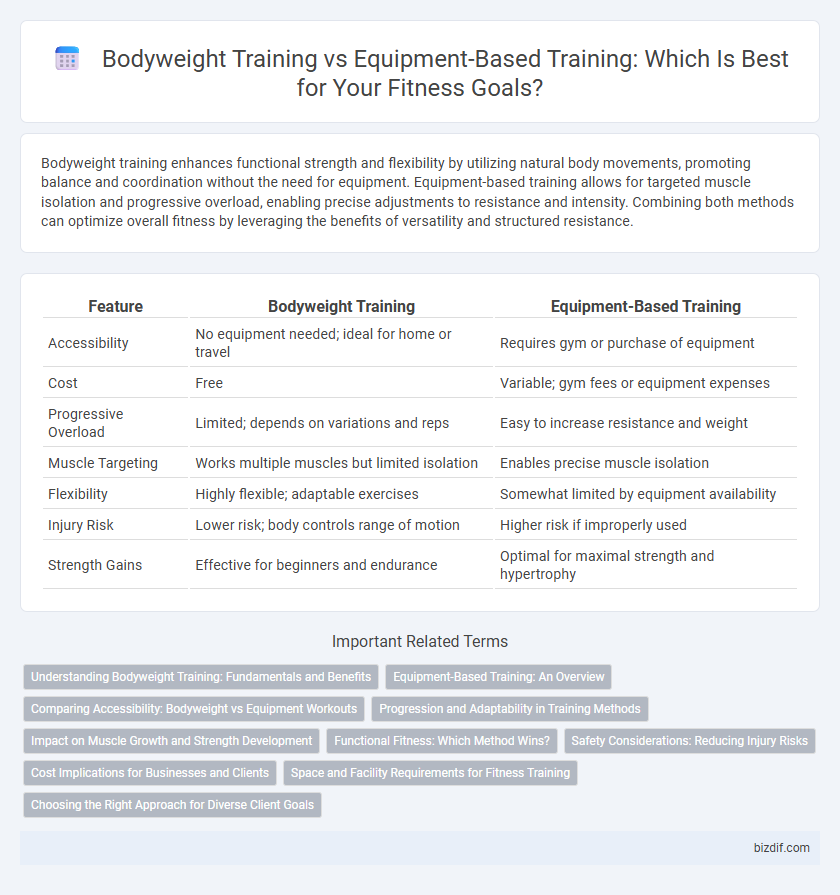Bodyweight training enhances functional strength and flexibility by utilizing natural body movements, promoting balance and coordination without the need for equipment. Equipment-based training allows for targeted muscle isolation and progressive overload, enabling precise adjustments to resistance and intensity. Combining both methods can optimize overall fitness by leveraging the benefits of versatility and structured resistance.
Table of Comparison
| Feature | Bodyweight Training | Equipment-Based Training |
|---|---|---|
| Accessibility | No equipment needed; ideal for home or travel | Requires gym or purchase of equipment |
| Cost | Free | Variable; gym fees or equipment expenses |
| Progressive Overload | Limited; depends on variations and reps | Easy to increase resistance and weight |
| Muscle Targeting | Works multiple muscles but limited isolation | Enables precise muscle isolation |
| Flexibility | Highly flexible; adaptable exercises | Somewhat limited by equipment availability |
| Injury Risk | Lower risk; body controls range of motion | Higher risk if improperly used |
| Strength Gains | Effective for beginners and endurance | Optimal for maximal strength and hypertrophy |
Understanding Bodyweight Training: Fundamentals and Benefits
Bodyweight training utilizes an individual's own weight as resistance, leveraging exercises like push-ups, squats, and planks to build strength, flexibility, and endurance without requiring gym equipment. This method enhances functional fitness by mimicking natural movement patterns and improving body control, coordination, and core stability. The convenience and adaptability of bodyweight training make it accessible for all fitness levels, promoting muscle engagement and calorie burning effectively in varied environments.
Equipment-Based Training: An Overview
Equipment-based training utilizes tools such as dumbbells, resistance machines, and kettlebells to target specific muscle groups, allowing for controlled and progressive overload. This method enhances strength, endurance, and muscle hypertrophy by providing adjustable resistance and varied movement patterns. Gyms often offer a wide range of equipment, enabling tailored workouts that accommodate different fitness levels and goals.
Comparing Accessibility: Bodyweight vs Equipment Workouts
Bodyweight training offers superior accessibility by requiring no specialized equipment, making it ideal for home workouts and limited spaces. Equipment-based training, while often providing more variety and resistance options, can be restricted by the availability and cost of machines or weights. Many fitness enthusiasts combine both methods to balance convenience with targeted muscle development.
Progression and Adaptability in Training Methods
Bodyweight training offers scalable exercises such as push-ups, squats, and planks that allow gradual increases in difficulty through variations and repetitions, making it highly adaptable for all fitness levels. Equipment-based training provides precise load adjustments with machines and free weights, enabling targeted muscle overload essential for progressive strength gains. Combining both methods maximizes progression potential by enhancing functional strength and muscle hypertrophy across diverse training goals.
Impact on Muscle Growth and Strength Development
Bodyweight training enhances muscle growth and strength development through functional, compound movements engaging multiple muscle groups simultaneously, promoting coordination and balance. Equipment-based training allows for precise muscle isolation and progressive overload with adjustable resistance, facilitating targeted hypertrophy and maximal strength gains. Combining both methods can optimize muscle adaptation by leveraging the benefits of variable resistance and natural body mechanics.
Functional Fitness: Which Method Wins?
Bodyweight training excels in functional fitness by enhancing natural movement patterns, balance, and core stability without reliance on external tools, promoting real-world strength and flexibility. Equipment-based training offers targeted resistance and progressive overload, enabling precise muscle isolation and strength gains essential for specific functional goals. Combining both approaches often yields the most comprehensive functional fitness results, leveraging bodyweight's adaptability and equipment's measurable resistance.
Safety Considerations: Reducing Injury Risks
Bodyweight training minimizes injury risks by relying on natural movement patterns and controlled resistance, reducing strain on joints and ligaments compared to heavy, equipment-based loads. Equipment-based training requires precise form and proper machine adjustment to prevent accidents, with improper use increasing the likelihood of muscle strains and joint injuries. Prioritizing correct technique, gradual progression, and awareness of personal limits is essential in both methods to ensure safety during fitness training.
Cost Implications for Businesses and Clients
Bodyweight training requires minimal financial investment, reducing overhead costs for fitness businesses and making it accessible to a broader client base. Equipment-based training demands significant upfront expenses for machines and maintenance, potentially increasing membership fees or session prices. Clients may benefit from the affordability of bodyweight routines, while businesses must balance equipment acquisition costs against client retention and service variety.
Space and Facility Requirements for Fitness Training
Bodyweight training requires minimal space and no equipment, making it ideal for small areas and home workouts. Equipment-based training demands dedicated space for machines, weights, and accessories, often necessitating a gym or specialized facility. Choosing training methods depends on available space, budget, and personal fitness goals.
Choosing the Right Approach for Diverse Client Goals
Bodyweight training offers versatile, accessible workouts ideal for improving functional strength, flexibility, and balance without the need for equipment, making it suitable for clients focused on mobility, endurance, or rehabilitation. Equipment-based training provides targeted resistance and progressive overload, essential for clients aiming to increase muscle mass, strength, or athletic performance through controlled movement and variable intensity. Assessing individual goals, fitness levels, and available resources ensures the optimal approach, often combining both methods for balanced development and long-term adherence.
Bodyweight Training vs Equipment-Based Training Infographic

 bizdif.com
bizdif.com